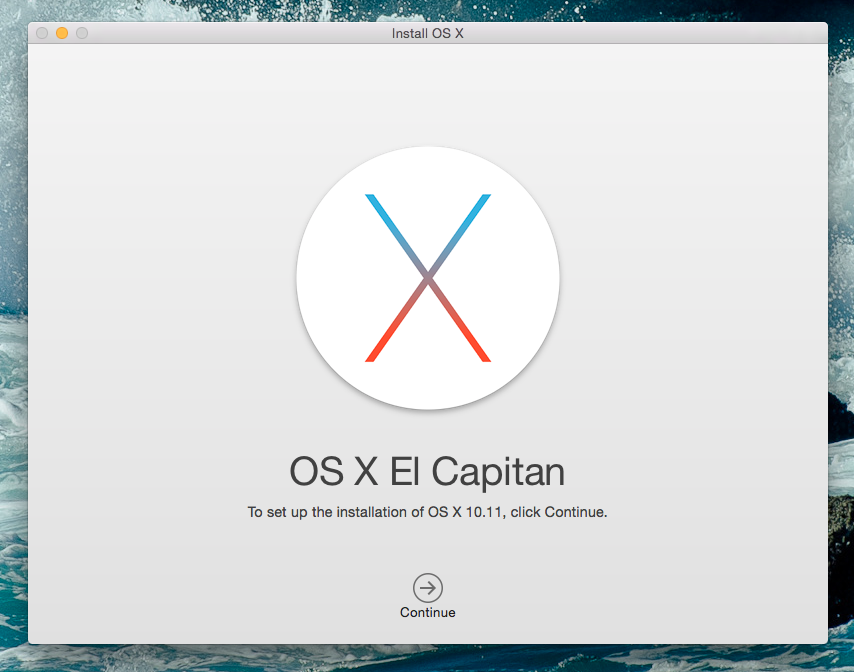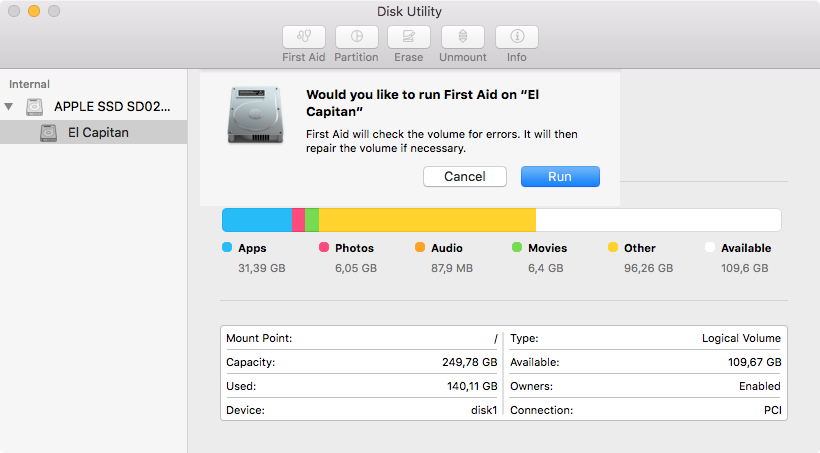

- RUN DISK UTILITY MAC COMMAND LINE EL CAPITAN FOR MAC OSX
- RUN DISK UTILITY MAC COMMAND LINE EL CAPITAN MAC OS
- RUN DISK UTILITY MAC COMMAND LINE EL CAPITAN MANUAL
- RUN DISK UTILITY MAC COMMAND LINE EL CAPITAN SOFTWARE
RUN DISK UTILITY MAC COMMAND LINE EL CAPITAN MANUAL
There are many additional functions that can be used with the appleRAID command, such as issuing manual or automatic rebuilds, setting timeout values, and adding or removing disks.

If you head back to Disk Utility, you’ll now see your new RAID volume listed in the sidebar, although you won’t be able to modify it without returning to the command line.Īs another example, if we instead wanted to create a RAID 1 volume called “Backup,” we’d use this command instead: diskutil appleRAID create mirror Backup JHFS+ disk2 disk3 The command will process for a few moments, and will automatically mount the new RAID volume when the operation is complete. Recalling that our two SSDs are disk2 and disk3, we’ll enter this command in Terminal: diskutil appleRAID create stripe Storage JHFS+ disk2 disk3 To use it, you’ll need to enter all of the RAID configuration info manually, including the type, name, and file system format.Ĭontinuing our example, we want to create a 2-disk RAID 0 volume called “Storage” with a Journaled HFS+ file system. Part of the diskutil command, appleRAID can be used to create and manage RAID 0 (striped), RAID 1 (mirrored), and JBOD (concatenated) volumes. Even though the GUI method for creating RAID volumes is now gone in OS X El Capitan, you can still access the basic underlying technology in OS X to perform most functions: appleRAID. With the correct disks identified, it’s time to build your RAID volume. So, as always, be careful and double-check your information before proceeding. If you pick the wrong disk number - something that could be easy to do if you have many attached drives - you could accidentally wipe your data. In our case, we see our 1TB disks with the TB1 and TB2 volumes and we can confirm that we’re working with disk2 and disk3.īe careful to select and verify the correct disk, as the next steps will erase any data on the drives. The disk number for each disk is located on the first line of each entry. You’ll get a list of each disk and volume currently connected to your Mac, along with other information such as partition scheme and name. Just launch Terminal and enter the command diskutil list. If you prefer to stick with Terminal, you can run the diskutil command to identify your Mac’s disk numbers.

In our case, our SSDs are disk2 and disk3. With the disk selected, find the Device box on the right side of the screen and note the disk number. In our example, we’re using two Samsung 840 EVO SSDs, so we’ll select one of the disks, not volumes, from the Disk Utility sidebar on the left. Looking at GUI method first, launch Disk Utility and select the first disk that is destined for your RAID volume. We can obtain this information in one of two ways: via Disk Utility or via the diskutil command line function. To illustrate how users can manage RAID volumes in OS X El Capitan, we’ll use an example in which we want to create a 2TB RAID 0 volume from two 1TB SSDs, labeled TB1 and TB2. The first step is to determine the disk number of each drive you wish to include in your RAID, as we’ll need this information for the Terminal command that will eventually create the RAID volume.
RUN DISK UTILITY MAC COMMAND LINE EL CAPITAN SOFTWARE
The process isn’t as simple as the old Disk Utility GUI, but for users running Apple’s latest desktop operating system, it’s the next best thing to investing in third party software SoftRAID.
RUN DISK UTILITY MAC COMMAND LINE EL CAPITAN FOR MAC OSX
To disable SIP for dtrace (and iotop) for Mac OSX 10.10 and above: For older OSX, you can ignore the following steps. If you are running on Mac OSX 10.10 (El Capitan) or later, then you need to first disable the SIP (System Integration Protection) for dtrace in order to run iotop because iotop uses dtrace.
RUN DISK UTILITY MAC COMMAND LINE EL CAPITAN MAC OS
The closest thing to getting IO r/w info is iotop command, which comes with all Mac OS (see disk_r and disk_w).


 0 kommentar(er)
0 kommentar(er)
